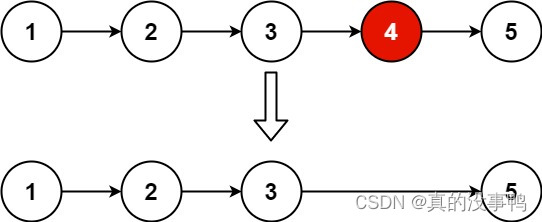题目描述
给你一个链表,删除链表的倒数第 n 个结点,并且返回链表的头结点。
示例 1:
输入:head = [1,2,3,4,5], n = 2
输出:[1,2,3,5]
示例 2:输入:head = [1], n = 1
输出:[]
示例 3:输入:head = [1,2], n = 1
输出:[1]
提示:
链表中结点的数目为 sz
1 <= sz <= 30
0 <= Node.val <= 100
1 <= n <= sz
进阶:一次扫描实现来源:力扣(LeetCode)
解题思路
首先这道题是要删除链表的倒数第n个结点,一种容易想到的方法是,先遍历一下链表获得这个链表的长度,这样我们就可以获得要删除的结点正着数的位置了。我们创建一个新的链表,遍历一下题目所给链表,把遍历到的节点加到新链表中,遍历到要删除的结点时跳过即可,最后返回这个新链表即可。
代码实现
/**
* Definition for singly-linked list.
* struct ListNode {
* int val;
* ListNode *next;
* ListNode() : val(0), next(nullptr) {}
* ListNode(int x) : val(x), next(nullptr) {}
* ListNode(int x, ListNode *next) : val(x), next(next) {}
* };
*/
class Solution {
public:
ListNode* removeNthFromEnd(ListNode* head, int n) {
ListNode* m=new ListNode();//新链表
ListNode* p=m;
ListNode* k=head;
int t=0;//链表长度
while(k)//遍历链表获得链表长度
{
k=k->next;
t++;
}
int w=t-n;//获得要删除的结点正着数的位置
int j=1;
while(head)
{
if(j==w+1)//遇到删除的节点跳过
{
head=head->next;
j++;
continue;
}
ListNode* q=new ListNode(head->val);
p->next=q;//将遍历到的结点加入到新链表中
p=q;
head=head->next;
j++;
}
return m->next;//返回新链表即可
}
};进阶要求我们扫描一次实现,想了半天没想出来,看了题解才知道要用双指针。双指针雀氏是一种非常妙的解法,没遇到这种题还真不好想出来。这道题用双指针就是用了一个前后指针,我们创建两个指针,一个前指针first,一个后指针second,我们让first超过second指针n个结点,那么first指针遍历到链表结尾的时候,second指针刚好就在倒数第n个结点,这样一次遍历是可以实现了。
代码实现
/**
* Definition for singly-linked list.
* struct ListNode {
* int val;
* ListNode *next;
* ListNode() : val(0), next(nullptr) {}
* ListNode(int x) : val(x), next(nullptr) {}
* ListNode(int x, ListNode *next) : val(x), next(next) {}
* };
*/
class Solution {
public:
ListNode* removeNthFromEnd(ListNode* head, int n) {
ListNode* p=new ListNode();
p->next=head;
ListNode* first=head;
ListNode* second=p;
for(int i=0;i<n;i++)
{
first=first->next;
}
while(first)
{
first=first->next;
second=second->next;
}
second->next=second->next->next;
return p->next;
}
};这道题还有一种解法,就是利用递归,递归也是一个非常好的想法,也很巧妙。按道理讲也是扫描了一次,下面是代码实现,仅供参考
/**
* Definition for singly-linked list.
* struct ListNode {
* int val;
* ListNode *next;
* ListNode() : val(0), next(nullptr) {}
* ListNode(int x) : val(x), next(nullptr) {}
* ListNode(int x, ListNode *next) : val(x), next(next) {}
* };
*/
class Solution {
public:
ListNode* removeNthFromEnd(ListNode* head, int n) {
int ans=find(head,n);
if(ans==n)
return head->next;
else
return head;
}
int find(ListNode* node,int n)
{
if(node==nullptr)
{
return 0;
}
int res=find(node->next,n);
if(res==n)
{
node->next=node->next->next;
}
return res+1;
}
};